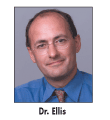Model predicts outcome of neoadjuvant endocrine Rx
An international team of researchers has developed a predictive model that accurately estimates which breast cancer patients may relapse after neoadjuvant endocrine therapy, Matthew Ellis, MD, PhD, said at the 2007 San Antonio Breast Cancer Symposium (abstract 62).

SAN ANTONIO-An international team of researchers has developed a predictive model that accurately estimates which breast cancer patients may relapse after neoadjuvant endocrine therapy, Matthew Ellis, MD, PhD, said at the 2007 San Antonio Breast Cancer Symposium (abstract 62). Dr. Ellis is director of the Breast Cancer Program at Washington University, St. Louis.
He noted that while a “fair amount of data” are available for estimating outcomes after neoadjuvant chemotherapy, there is “relatively little” in the setting of neoadjuvant endocrine therapy.
The study involved patients from P024, a trial comparing letrozole (Femara) with tamoxifen in 337 women. Letrozole was associated with a greater decline in Ki67, and patients who achieved a cell cycle complete response (< 1% Ki67 staining in the surgical sample) had superior relapse-free and breast-cancer-specific survival. The final multivariate analysis, which led to the predictive model, was based on 146 subjects for whom data on surgical staging, confirmed baseline ER positivity, and post-treatment Ki67 values and ER status were available.
Recurrence-free survival (RFS) at 5 years was nearly 100% for patients whose tumors were downstaged after treatment to stage I/0, compared with approximately 50% for stage II/III patients. Similarly, other independent post-treatment features favorable for RFS were negative nodes, clinical response, low histological grade, Ki67 staining < 1%, and persistence of ER positivity.
Of most interest, patients who remained persistently ER positive (cut-off Allred 2) had a substantially better outcome than patients who became ER negative after treatment. At 30 months, RFS was > 75% vs approximately 50%, and overall survival was > 90% vs approximately 60% in the two groups.
The baseline ER positivity levels were not different between patients with persistent positivity and those who became negative. “This finding suggests that after neoadjuvant endocrine therapy it is worth re-checking ER status,” he said.
Risk score
These independent predictors were put into a multivariate analysis to produce a risk score based on points that were assigned according to the hazard ratios of each.
“In the final multivariate model, tumor and nodal stage along with degree of Ki67 staining and loss of ER positivity on-treatment were the most important independent variables for predicting outcome,” Dr. Ellis noted. “Bootstrap analysis suggests a very valuable prognostic index.”
RFS was highly significantly associated with risk score (P < .0001). At 5 years, relapses were observed in 7% of patients (1/14) in the lowest risk category (risk score 0-1); in 21% (15/71) in the low-intermediate category (risk score 2-5); in 55% (31/56) in the high-intermediate category (risk score 6-9); and in 100% (5/5) in the highest risk category (risk score 10-13), Dr. Ellis reported.
A UK-based group will prospectively validate these findings in a 4,000-patient trial that will randomize patient treatment to perioperative endocrine therapy vs initiating endocrine therapy in a standard way after surgery, he said.
Newsletter
Stay up to date on recent advances in the multidisciplinary approach to cancer.